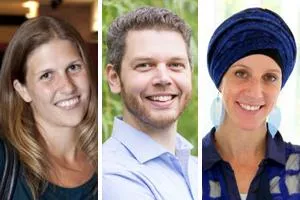
Pollution and social identity: UTM professors to give talk about ‘outstanding’ research
A kiss on the hand imbued with significant social meaning, ethnic identities constructed by lines drawn on a map and cyclists’ exposure to pollution. These are the issues three award-winning UTM professors will touch on during the upcoming Annual Research Prize Symposium.
Winners of this year’s UTM Annual Research Prizes, which are awarded to early career faculty members who have made outstanding contributions to research, will each talk about their research.
The themes at this year’s talk, which takes place Thursday, Nov. 28, focus on urban pollution, Muslim identity and the role of cartography in modern Africa.
Matthew Adams, assistant professor and GIS program advisor with the Department of Geography, is looking at urban air pollution. Using passive air pollution monitors and a mobile laboratory that provides real-time data, Adams and his team are mapping pollution to build an understanding of how urban features impact the air we breathe.
Focusing on transportation-related pollution, he has found that people who live a couple of hundred metres from a highway are exposed to a lot of transportation-related pollution. Move just a kilometre out from the highway, though, and the pollution is far less noticeable, he says.
His research has also revealed that super commuters – those who drive 1.5 to two hours a day – are “surrounded by this very dense pollution source.
“These are environments in which people spend their time and we want to know how those different environments can affect someone’s individual exposure,” Adams says. “We’re starting to realize within the city not everyone is being exposed the same way and there are behaviours and activities that can control a lot of the exposure.”
It may seem that adjustments can greatly reduce exposure to pollutants, but it is more nuanced than that, and people may find they are trading one type of exposure for another. Cyclists, for example, can reduce exposure to pollutants directly emitted from vehicle exhaust by choosing bike paths instead, Adams explains, but as one moves away from roads, the amount of ozone exposure starts to increase.
“It’s kind of a balance of what you’re being exposed to,” Adams says. “Your individual behaviour really controls your air pollution exposure.”
Being a good Muslim during globalization
Associate professor Sarah Hillewaert from the Department of Anthropology is challenging stereotypes about Africa, showing that youth along the East African coast are active participants in the global process.
Her research focuses on how young people in Lamu are negotiating social relations during a time of substantial change and globalization, using what she calls “strategic social tools.”
Economic marginalization has led to a “sense of crisis in the community,” Hillewaert says, explaining young people want jobs and economic development, yet there is also political significance to holding onto their identity.
This is leading to a shift in understanding what it means to be a good Muslim, Hillewaert says, with both young men and women crossing the boundaries of respectability. For example, women now leave the house to attend college and work, where they once would have remained segregated as a show of wealth and status.
Yet in their everyday interactions, Hillewaert notes both young men and women are finding ways to demonstrate they can be educated, employed and successful while still being a respectable Lamu person. It can be in how they dress, where they walk, or even how they approach a seemingly simple greeting like a hand kiss.
Creating identities with mapping
All identities are invented, and mapping is central to the invention of a group, says Julie MacArthur, an assistant professor with UTM’s Department of Historical Studies.
And nowhere in the world is there a neutral boundary, she adds.
This is evident in Africa, where colonialism was a mapping project and cartography was a tool that shifted the way people expressed and argued identity, MacArthur says.
For example, the Luyia, Western Kenya’s second-largest ethnic group, didn’t exist before the 1930s, MacArthur explains. Their identity was created after gold was discovered in the region. Mapping the land and creating territorial space to combat encroachment was so important, the various groups made an argument as to why they were one group and constructed an ethnic identity.
“They were responding to the colonial state vision of African communities,” MacArthur says, adding they realized they would be best served identifying as a single community.
Yet the Luyia don’t function as an ethnic group insofar as they do not have a single language, they don’t have the same cultural practices and they don’t share a common myth of ancestry, MacArthur explains. Their identity, like all identities, is invented and imagined, she says. And mapping was key to that creation.
With secessionist movements and the reconfiguring and reemergence of communities in Africa, MacArthur’s research is now focused on alternative mappings of decolonization and how Kenya and other regions are trying to naturalize boundaries.
Professors Adams, Hillewaert and MacArthur will each speak at The Annual Research Prize Symposium on Thursday, Nov. 28 from 1-3 p.m. at Maanjiwe nendamowinan, MN 3230. The symposium is open to faculty, staff, students and postdocs. Refreshments will be served. RSVP to rong.wu@utoronto.ca
